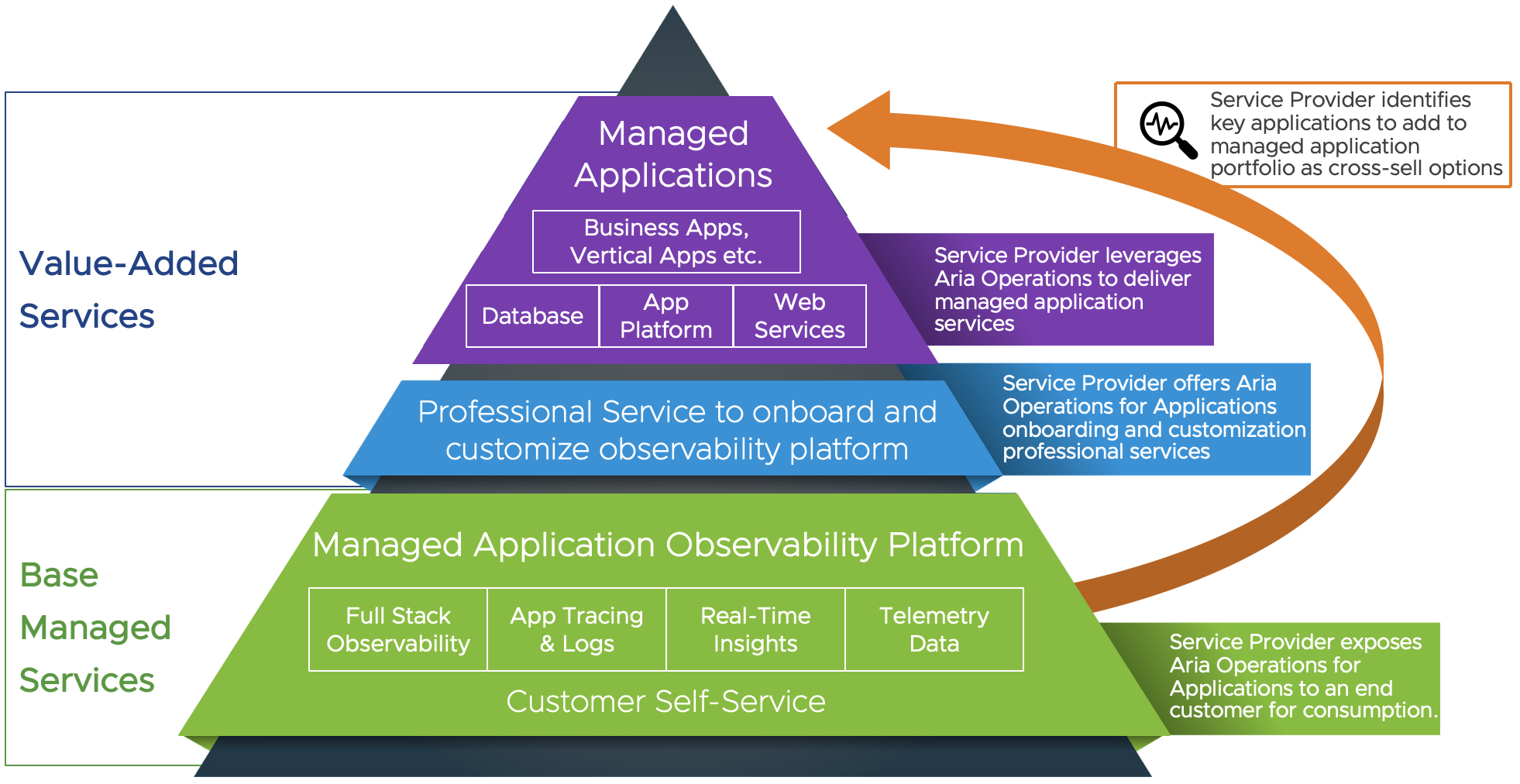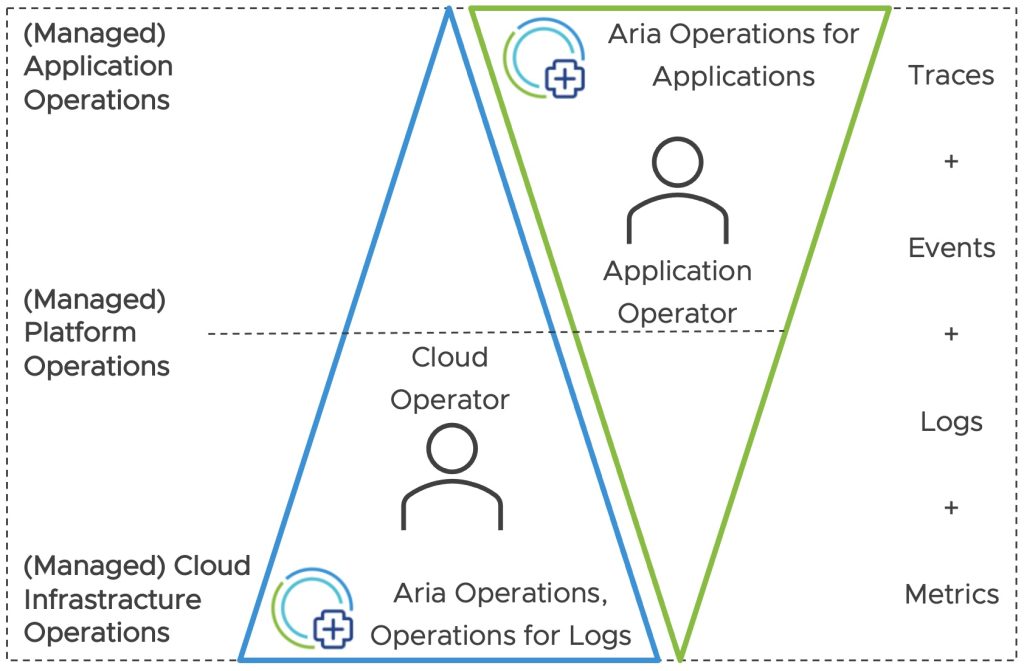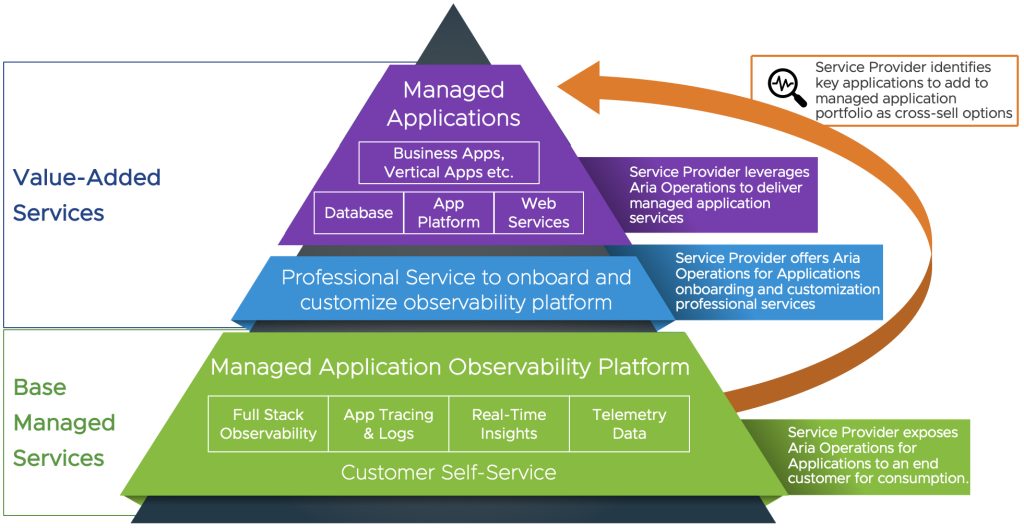
Welcome to Managed Services Monday with VMware Aria – Part 5! This week we are going to focus on managed applications. In previous weeks, we covered how providers can give customers a secure landing zone to consume resources from multiple clouds. We also went deeper on advanced automation and GitOps to make the multi-cloud environment scalable for the provider and the consumer. Last week, we discussed how to build and offer a set of value-added managed multi-cloud infrastructure services.
With this foundation, the cloud-consumer should be ready to deploy applications in a cloud-smart way: By selecting the best possible cloud for any given application and use-case. And service providers, internal and external to the customer, can build additional managed services around these applications:
 Figure 1: Shared responsibility model for application services
Figure 1: Shared responsibility model for application services
Monitoring vs. Observability
The Aria solution that needs to be added to the previously described stack, is Aria Operations for Applications. VMware Aria Operations for Applications provides a unified observability multi-cloud management solution with single-source-of-truth visibility and contextualized information across logs, metrics, and traces for greater business agility while maintaining SLAs. It provides answers as to why something is wrong and how to fix it. The previously described Aria Operations, Operations for Integrations and Operations for Logs solutions may seem to have overlap with Aria Operations for Applications. To better understand the differences, target personas and use-cases, let’s compare monitoring and observability and how they relate to the solutions discussed:
 Figure 2: Monitoring vs. Observability
Figure 2: Monitoring vs. Observability
Without going too much into detail, figure 2 can be summarised in two key statements:
- Infrastructure operations requires metrics and logs from Aria Operations and Operations for Logs.
- Application operations additionally requires events and traces from Aria Operations for Applications.
There are certainly practices in between those two, like platform operations. Also, depending on the use-case, Aria Operations is absolutely capable of monitoring platform components and applications. And Aria Operations for Applications is absolutely capable of providing visibility into platforms and infrastructure.
The key here is the difference in target personas and their needs. Cloud operators that provide (managed) infrastructure services, put strong focus on metrics and logs. They need to manage capacity, performance and stability of relatively static or similar components. We already looked at this in the last post. Application and full-stack operators additionally need to understand events, traces and flows in applications and through the full stack. And this unified view becomes increasingly important in distributed micro-services and multi-cloud applications. To further support this unified view from both directions, there is also a management pack available for Aria Operations for Applications. The following in-depth video shows the integration and the troubleshooting user experience from both directions:
“,”content”);]]>
In a service provider environment, managed infrastructure services and managed application services will very likely be delivered by separate teams. And unlike managed infrastructure, managed application services are likely to only address a subset of customer workloads. Applications are too diverse, specific, and often customized to handle holistically as a managed service provider. Instead, providers will typically focus on a set of standard applications (e.g. business or industry-leading solutions for a given vertical). And they will offer managed services for key application and platform components such as databases (e.g. MySQL, PostgreSQL etc.), Web Servers (ISS, Apache, Tomcat, NGINX etc.), App Platforms (e.g. AWS ElasticBeanstalk, Google App Engine, Tanzu Application Service etc.) and many more.
Standardised Services via flexible Platform
The key in selecting the right applications and application components to offer managed services for, is finding the balance between existing skills of the service provider and revenue potential across the addressable market. The latter can also inform a roadmap of future managed application services based on new capabilities that are yet to be developed and new customers that can be addressed. Whatever that roadmap looks like for the managed service provider, Aria Operations for Applications will likely have an integration to support it:
 Figure 3: Aria Operations for Applications integrations
Figure 3: Aria Operations for Applications integrations
The above figure displays nicely why Aria Operations for Applications provides the ideal foundation for adding managed application services:
- It integrates with Aria solutions previously discussed for building a managed services practice for multi-cloud, giving providers and customers a unified management experience where needed.
- Aria Operations for Applications can ingest data from cloud services of all relevant platforms. This includes AWS, Azure, GCP and VMware Cloud, supporting the customers multi-cloud journey.
- Like other solutions we covered, it supports a range of open-source and commercial developer tools. These help incorporates GitOps and DevOps principals into the managed services practice, for example using JIRA, GitLab and GitHub.
- It can help manage a wide range of applications and application components. This flexibility allows the provider to take a phased approach to launching their managed application portfolio without having to change or add management tools later down the road.
Phased Service Launch
The last point is particularly interesting for planning and expanding the managed applications services portfolio roadmap. The provider can start with the key applications and offer fully or partially managed services for those right out the gate. From here, they need to make a data-driven decision about where to expand to. And that data can be gathered by offering the Aria Operations for Applications platform as a self-service, too.
Even such a self-service observability platform can still create significant value for customers. According to the latest State of Observability report, an increasing number of users report challenges with monitoring cloud application environments. These are mainly lack of unified visibility slowing down incident resolution, lack of insights into cloud usage and limited visibility:
 Figure 4: Challenges faced when monitoring cloud application environments
Figure 4: Challenges faced when monitoring cloud application environments
This approach, offering key managed applications as well as a self-service observability platform, allows cloud consumers to have observability for all of their applications. At the same time, the service provider can learn which applications and components are widely in demand and use from customers. From here, they would start building out additional managed application services accordingly:
 Figure 5: Growing from base service to value-added services portfolio
Figure 5: Growing from base service to value-added services portfolio
Customer Onboarding and Application Management
Aria Operations for Applications is available as SaaS only. Hence there is very little effort to create a base managed service that allows customer self-service of the solution. Such a base service is on-par with the user experience in a hyperscale cloud setting. Comparable public cloud services from hyperscalers are AWS X-Ray, Azure Application Insights or Google Cloud Operations. To establish this, the provider only needs to onboard consumers and create a subscription in Cloud Partner Navigator:
“,”content”);]]>
“The new Aria branding replaces three existing cloud management brands: vRealize portfolio, CloudHealth by VMware Suite, and Tanzu Observability by Wavefront.”
https://blogs.vmware.com/management/2023/04/aria-rebranding.html
The degree to which providers offer managed applications will vary greatly. As outlined earlier, this will be based on various factors such as complexity, standardization, type and deployment of application, as well as the providers’ know-how and resources to manage them. And it can include a wide range of activities and demarcation lines between the consumer and the provider. Examples of these activities are lifecycle management, capacity management, performance management, availability management, security management, as well as optimization, transformation or migration services. As diverse as these types and flavors of managed application services are, as important is building it on the right platform. Let’s conclude with a brief look on how Aria Operations for Applications can support application management on a high level:
“,”content”);]]>
Summary
To summarize, a managed application business can come in various forms depending on the type of applications and degree of management required. The key consideration for managed service provider is which platform can support this business. This should be irrespective of the application, it’s architecture and the cloud it is deployed in. Aria Operations for Applications, in combination with the rest of the Aria platform that we covered in previous posts, builds this ideal foundation. From there, providers can develop their skills and application-specific capabilities in all directions that are required to create value for their customers.
As always, stay tuned for next weeks Managed Service Monday, this time on managed networking. And don’t hesitate to reach out to your account team if you have any questions or want to learn more.
